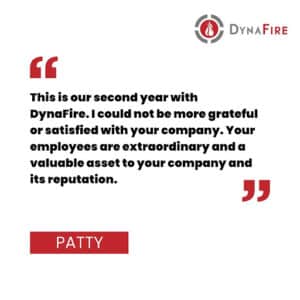When you think about Miami fire extinguisher hydrostatic testing, does your mind fill with dozens of burning questions you need answers for? We know the feeling.
Portable fire extinguishers save lives and property. These devices can quickly extinguish small fires, preventing them from growing and causing more damage and threat to building occupants. Fire extinguishers can also clear paths of egress in larger fires, allowing building occupants to exit a building in an emergency safely.
Like everything else on your commercial property, a fire extinguisher is only worth anything when it works. Otherwise, it might as well be an unusual choice in wall decor. Miami fire extinguisher hydrostatic testing is a key component of your maintenance plan, and our Fire & Life Safety experts are here to answer your questions.
Your Miami Fire Extinguisher Hydrostatic Testing FAQs Answered
Which types of fire extinguishers require hydrostatic testing?
Any rechargeable fire extinguisher will need hydrostatic testing. The purpose of this test is to ensure the extinguisher is free from leaks and is strong enough to withstand the pressure that is maintained in the extinguisher.
How often do you hydrostatic test fire extinguishers?
Depending on the type of rechargeable fire extinguishers you have on your property, the testing schedule you follow can be different. Typically pressurized water, wet chemical, and carbon dioxide fire extinguishers will need to be tested every five years. Dry chemical fire extinguishers will need to be tested every 12 years. Dry chemical fire extinguishers include the ‘ABC’ fire extinguishers that are commonly seen in offices and other spaces where they are usable on the majority of fires that may be encountered there.
If you’re not sure what kind of extinguishers are present on your property, it’s time to find someone who is. Our expert fire extinguisher technicians can verify your extinguisher types and get you started on a maintenance and testing plan that works for your budget and keeps your property in compliance with fire code.
How is hydrostatic testing conducted?
Fire extinguishers need to go through a variety of inspections, including monthly visual checks that you can conduct yourself (or work with a professional to complete), annual maintenance that must be completed by a fire professional, and hydrostatic testing. Hydrostatic testing must be completed by individuals who are trained and certified to conduct these tests, and that’s our team at DynaFire.
To begin the hydrostatic testing process, the extinguisher must be visually inspected and discharged. At this point, we’re able to inspect the interior of the extinguisher’s cylinder. We’re looking for signs of damage or any flaws that could impact the function of the extinguisher and the safety of the user. We then begin the pressure test. We follow NFPA 10 standards and use water to pressurize the fire extinguisher behind a protective barrier. During this test, we will monitor the pressure. We’re looking for any drop in pressure, which would indicate it’s time to remove the extinguisher from service.
If the extinguisher passes the test, we’ll clean it up, replace any disposable parts, refill and repressurize it, and return it to its designated location so it’s ready for action.
Who Has The Best Fire Extinguisher Service in Miami?
Finding the right team to conduct your Miami fire extinguisher hydrostatic testing doesn’t have to be hard. Just take a look at our 5-star reviews, learn more about our Core Values, and you’ll know it’s time for you to work with a Florida-based fire protection company like us. Give us a call today to get started!






